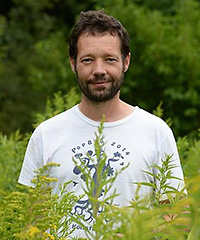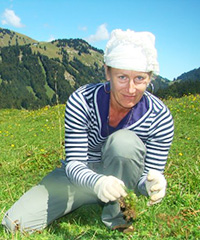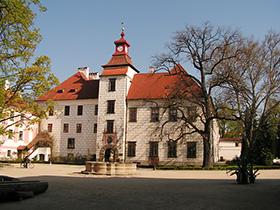Keynote speakers
 Francesco de Bello
Francesco de Bello
Functional traits as determinants of population spatial and temporal patterns
Understanding the processes regulating populations’ spatial and temporal patters is crucial to predict changes in species distribution under different global change scenarios. Functional traits, phenotypic attributes linked to species fitness, are hypothesized to provide an ideal tool for such predictions. A number of studies have tried to demonstrate that traits play a crucial role in determining the success or failure of species in a given environment and species’ abundance within a landscape. Similarly it has been hypothesized that population temporal variability could be driven by functional trait trade-offs in resource acquisition and growth rate strategies. While reviewing the extent of empirical evidences supporting this set of hypotheses, I will highlight perspective areas of research by using various case studies based on functional traits. Notably, the effect of trait syndromes, i.e. how different combination of trait could results in similarly viable strategies, needs further developments. Further, relating species spread to functional traits requires accounting for the potential occurrence of species, and not only the observed spread, to better uncover dispersal, abiotic and biotic processes that filter species’ traits.
http://www.butbn.cas.cz/francesco/Webpage/Home_-.html
 Mark van Kleunen
Mark van Kleunen
Plant naturalization: from global patterns to regional and local drivers
The search for drivers of plant naturalization can be done at global, regional and local scales. Through the Global Naturalized Alien Flora (GloNAF) database, we now have the first overview of the worldwide extent and patterns of plant naturalizations. So far, this has revealed that plant naturalizations are not happening at random with respect to geography and taxonomy, and that bilateral trade plays a pivotal role in the distribution of naturalized alien plants around the world.
A major pathway for introduction of alien plants into new regions is horticulture, which might result in the biased introduction of ornamental species with certain characteristics. We used path analysis of trait, introduction and naturalization data to unravel the direct and indirect effects of traits on naturalization success of ornamental plant species in Germany. Furthermore, using a data set of Asian woody species that have been introduced to Europe, we could show that climatic suitability is one of the major drivers of naturalization success. Given that many of the non-naturalized ornamental plants in Europe originate from warmer regions, they may have a head start under climate change. Using distribution modelling for almost 800 ornamental species, we have predicted the potential future invasion hotspots in Europe.
While analyses of global and regional databases provide important clues about the potential drivers of plant naturalizations, and could inform management, the actual naturalization process (population establishment) happens at the local community scale. Therefore, I will end my presentation with several examples of local introduction experiments that are currently underway in my group. These studies address the role of functional traits, phylogenetic relatedness and responses to climate change, and should provide insights into the mechanisms driving the local, and consequently regional and global naturalization success of plants.
http://cms.uni-konstanz.de/vkleunen/the-team/mark-van-kleunen/
 Filip Kolář
Filip Kolář
Ecological and evolutionary significance of polyploidy: new insights from population studies
The evolutionary significance of polyploidy (multiplication of chromosome number above the diploid state) has intrigued biologists for over a century. It has arisen early in the diversification of eukaryotes and, more recently, in many extant lineages, especially within plants. Much research on ecological and evolutionary significance of polyploidy has emerged in recent years. Analyses of cytotype diversity, abundance and distribution have increased due to the availability of flow cytometry, which permits high-throughput surveys of ploidy diversity in natural populations. These studies have characterized cytotype diversity from fine to coarse spatial scales, and explored cytotype interactions using experimental and comparative approaches. Furthermore, research in mixed-ploidy species has become more multidisciplinary, taking ecological, reproductive, evolutionary, phylogenetic and genomic perspectives. The synergies between these research approaches have, in turn, contributed novel insights into the impacts of genome structure on phenotype, ecological interactions, and adaptive divergence. I will provide a synthesis of knowledge on the ecological and evolutionary significance of polyploidy by addressing the following themes: (i) What are the extent and spatial and temporal scales of ploidy diversity in natural populations? (ii) What is the extent of gene flow between ploidy states and what mechanisms may regulate opportunities for gene exchange? (iii) What are the mechanisms and factors regulating the establishment of polyploids within, and expansion beyond, diploid populations?
https://botany.natur.cuni.cz/kolarf/
 Mari Moora
Mari Moora
Secret partners of plants: contribution of arbuscular mycorrhizal fungi to the plant performance and community dynamics
Classical plant ecology relies on recording visible, well-recognizable traits, processes and patterns. For example, different plant species are determined using morphological characteristics and their abundance is measured or estimated visually. While we recognize plants well, we often ignore an inevitable feature of the great majority of land plants- they are not just plants but they are mycorrhizal plants. This means that the visible patterns which plant individuals, populations, species and communities exhibit in nature are mediated by their root inhabiting mycorrhizal fungi. In this talk I shall (1) introduce the partners and their role in mycorrhizal symbiosis; (2) explore the ways how being mycorrhizal influence plants’ performance at different scales (from individual to species level, from local community to ecosystem level); and (3) discuss the variation of arbuscular mycorrhizal fungal communities and the impact of this variation on the host plants across environmental gradients.
http://www.botany.ut.ee/planteco/en/staff/mari_moora.html
 Katie Suding
Katie Suding
The importance of niche dynamics in restoration and conservation
In this era of rapid environmental change, we are increasingly being faced with two challenges: how to conserve native rare species and how to control the dominance of exotic invaders. Research aimed at these challenges often looks to species traits to better understand what allows a plant to invade or stay rare. I will go back to classic niche-based arguments about determinants of abundance, and suggest that we are missing a fundamental piece of this puzzle applied to management: dynamics when rare can be quite different than dynamics when a species is abundant. These frequency-dependent effects can come into play to affect resilience following disturbance, restoration trajectories, and response to environmental stochasticity. I will talk about several projects from my research group where we find that frequency dependency influences whether a species is at high extinction risk when rare, whether an invader can capitalize on a changing environment, and whether our interventions affect restoration success.
http://www.colorado.edu/sudinglab/







